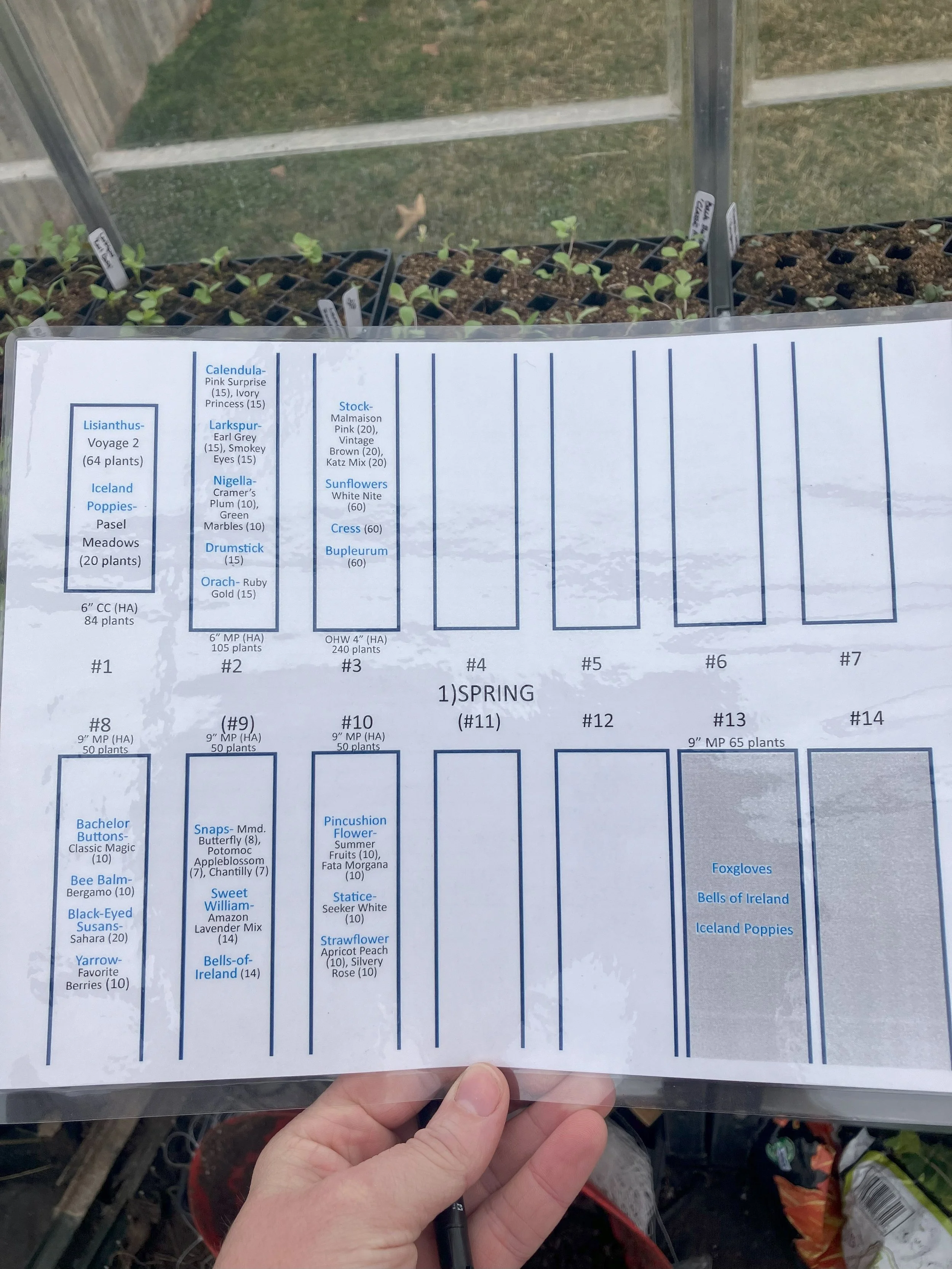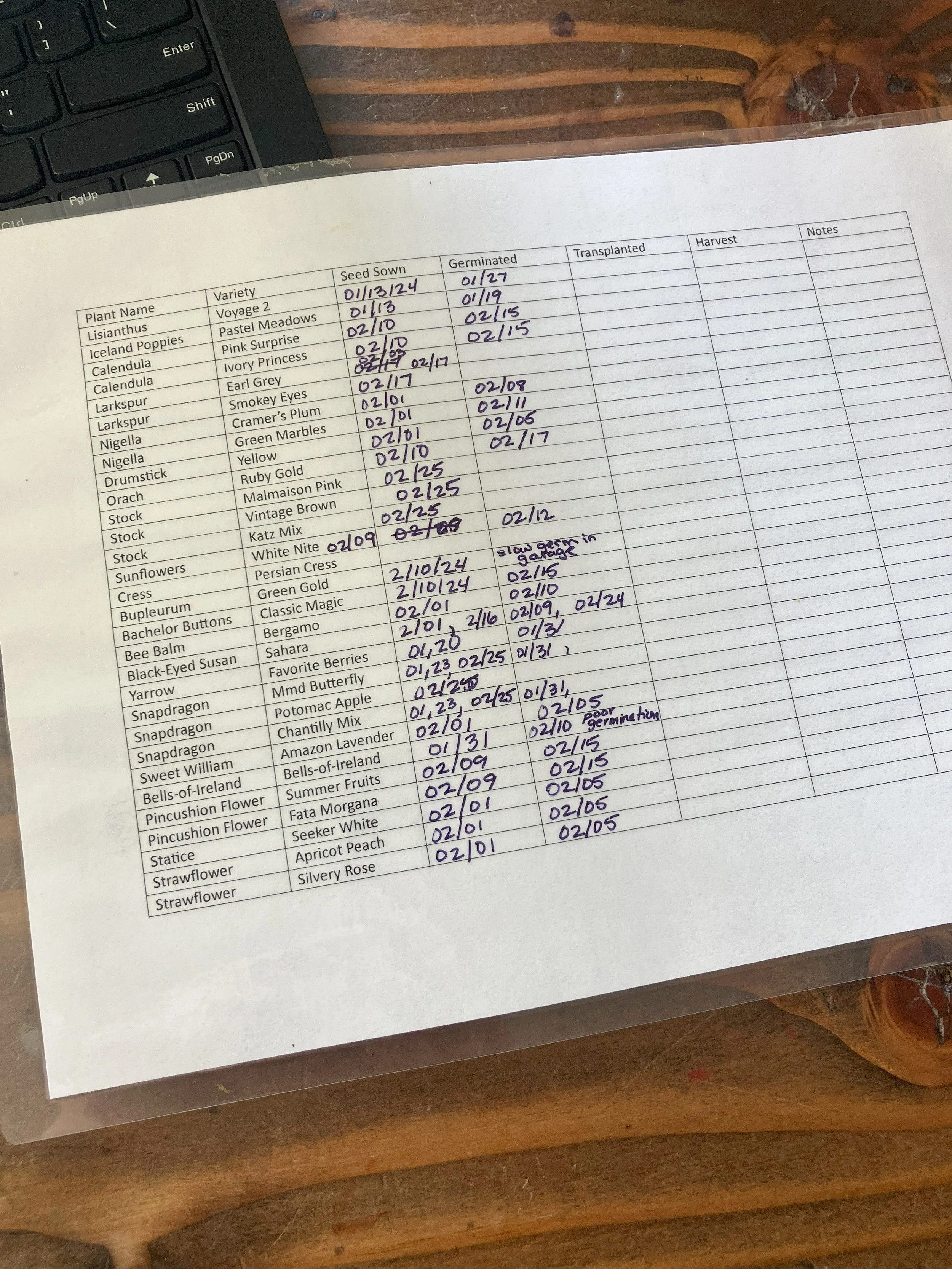Planning a Cut Flower Garden
Each great season begin with a plan.
Last year I planted all my plants at the same time- two weeks after my last spring frost. I only had nine garden beds, and I wanted every one of them to be in bloom when I was delivering flowers to my CSA subscribers. I knew that there were advantages to succession planting in theory, but I just couldn’t wrap my head around how to do it in my own garden.
But last year, I noticed a lot of flowers, including Bells of Ireland, Black-eyed Susans, and Nigella, all had really short stems, which made them unusable in bouquets. It turns out all these flowers belong to a group called “hardy annuals”, and they need to establish their root system in cool weather to produce long abundant blooms. Hardy annuals should be planted 6-8 weeks before the last frost, not two weeks after.
Also, even though I planted everything out at the same time last year, some plants produced flower after flower all season long, while others produced only one (or just a few) per plant before they quit blooming. By the end of the season, I had a few beds that were still producing tons of flowers, and a lot of beds that were pretty much empty, or at least sad looking.
I think succession planting will remedy both problems! My plan for the garden this year includes 1) an early spring planting, 2) an early summer planting, 3) a mid-summer planting, and 4) a fall planting. I have 14 garden beds to plant, and I want to be confident that in each planting I have all the ingredients I need to make bouquets. The ingredients that are important to me include: focal flowers, spikes, disks, filler, and airy flowers.
EARLY SPRING PLANTING
The only plants that I can plant in early spring are hardy annuals, so the first step for my plan was to write a list of hardy annuals that fill each of those categories. Here is an example of each category that I could grow in early spring:
Focal- Narcissus (pictured here)
Spikes- Snapdragons
Disks- Black-eyed Susans
Filler- Bells of Ireland
Airy- Bachelor Buttons
I know that I need more than one flower in each category, so I go through and add all the flowers I want to grow that are hardy annuals. Once I have that list, I look at my growing space. I have 14 garden beds, but I don’t want to plant them all out with my hardy annuals. I want to save space to plant in early summer. So, I tried to dedicate about a third of my garden beds to hardy annuals. This year I actually am planning on planting in half, but it’s a step in the right direction.
Now, I need to decide where all these flowers are going to fit in my seven allotted beds. I stick plants together that 1) have the same growing space requirements, and 2) similar flowering habits. In my garden, I plant all of my hardy annuals at 4”, 6”, or 9” spacing.
The only plants that I plant 4” apart are those that produce one flower and then they are done, like non-branching sunflowers. So, I have one garden bed dedicated to these one-hit-wonder plants that I plant very close together- one bed done!
About half of the 6” plants produce a medium amount of flowers- more than the one-hit-wonders and less than the true cut-and-come-agains. The other half produce tons of flowers and are cut-and-come-agains. I dedicated one bed to 6” medium producers, and another to 6” cut-and-come-agains. Three of seven beds spoken for.
The last four hardy annual beds are filled with 9” medium producing flowers. One bed is in partial shade, so I will be careful about only putting shade plants there, but otherwise I divvy the plants between the beds and I am good to go for my spring diagram! I’ve included a picture of what my end result looks like.
My last step for preparing for my spring planting is figuring out when to start and transplant these seeds. My frost date is the end of April, so I count back 8 weeks and record that date, March 4th, as my transplant date for these hardy annuals. Now I go through each flower that I want to transplant and write on my calendar when I need to start them indoors. Some need a long time to grow, like lisianthus, while others grow quickly, like bachelor buttons. My favorite resources to find when to start flowers are Floret Library, Johnny’s Flower Library, and also just checking the back of your seed packet.
I added a chart on the back of my garden plans so I can easily keep track of my seed starting, germination, transplant, and harvest date. I tried to use a computer last year and just didn’t record a bunch of stuff because it was too big of a hassle to pull out my computer.
Wow, all that for just my first planting! But all the same principles apply to the rest of my garden plan.
EARLY SUMMER PLANTING
My early summer planting is my first opportunity to plant out tender annuals. Tender annuals, like zinnias and sunflowers, will die in frost. I plant these guys out two weeks after my last projected frost, just to be on the safe side.
I do the same planning, coming up with focal, spikes, filler flowers, etc, but this time I can use tender annuals, and any hardy annuals that will do okay in a little warmer weather. Once I have my list, I divvy them between my remaining 7 garden beds the same way I did for my early spring planting.
This year I am taking up three of my garden beds with dahlias, so that only leaves 4 for my annuals, but these blooms will all overlap with the early spring blooms, so I will theoretically have tons of blooms that carry on from each planting.
Again, I go through all of the flowers I have on my list, including any hardy annuals I am replanting, and figure out the date I need to start the seeds in order to transplant them in mid-May.
MID SUMMER PLANTING
Okay, this is where I am a little nervous. To plant in mid-summer, like late July/early August, I will have to pull up a bed of my hardy annuals and replace them. My theory is that the cut and come again flowers may still be producing, but the medium producing, and one-hit-wonder flowers will be ready to come out. I will have to be brutal and pull them out even if they are still flowering.
I want to replace these medium producing hardy annuals with heat loving tender annuals, like celosia and zinnias. Again, I go through and figure out when I want to transplant them, I am guessing August 1st, and then write when I need to start each seed indoors to get it ready to transplant.
FALL PLANTING
The fourth, and final, planting this summer is actually for next spring. There are tons of hardy annuals that can overwinter in my growing zone. I grow in zone 7a. You can find your grow zone HERE (I am sure there are a lot of other resources to find that information online too).
By starting hardy annuals and transplanting them, or direct seeding them about 6-8 weeks before my first fall frost, they should be big enough to establish a good root system and grow even earlier for next spring. I am going to try to overwinter a few favorite hardy annuals, including snapdragons, bells of Ireland, black-eyed Susans, and Iceland poppies (to name a few). A great resource for learning more about hardy annuals is the book Cool Flowers, by Lisa Mason Zeigler.
My first frost is predicted to be October 13th. August 18th is 8 weeks before my frost, so that is the earliest I would want to transplant for overwintering. Maybe later if I get low-tunnels, which I definitely want. The last step is to record when to start each of these flowers on the calendar and figure out where they go in the garden.
I really love the planning stage. I love picking out all the colors and varieties of flowers. I love how there are absolutely no mistakes yet. I love the possibility a good garden plan holds. I am learning so much each year from my success and failures. I can’t wait to share them all as I grow!
Until next time,
Anna






